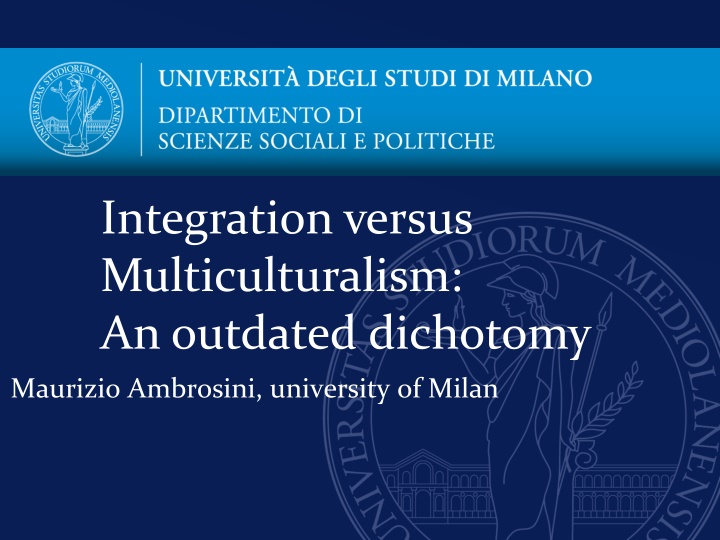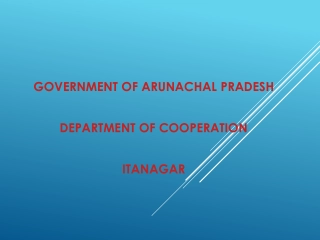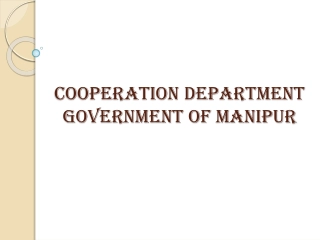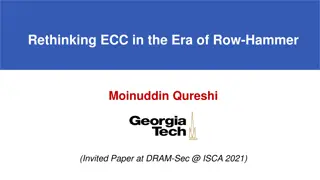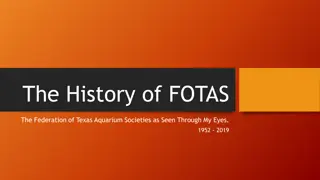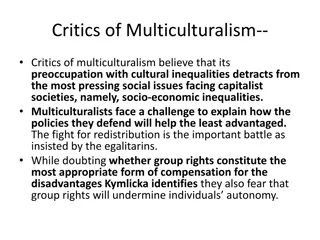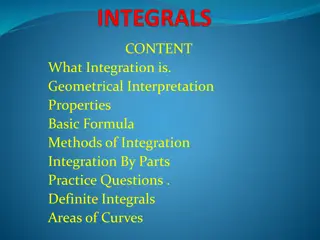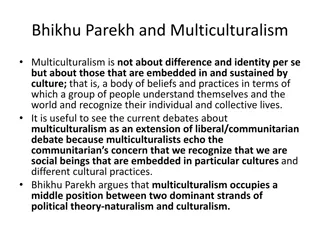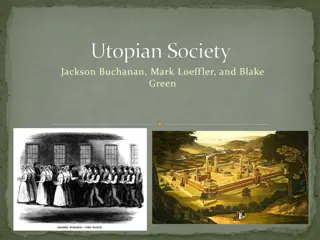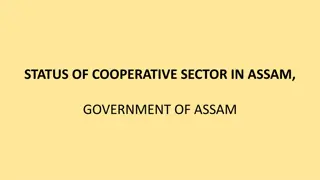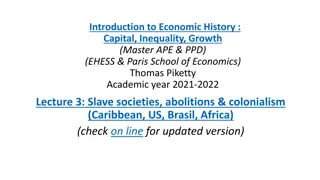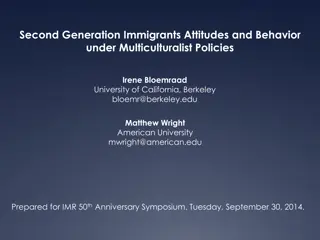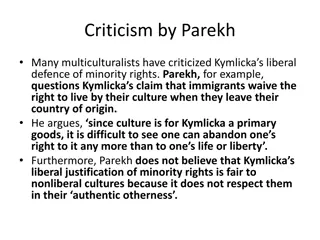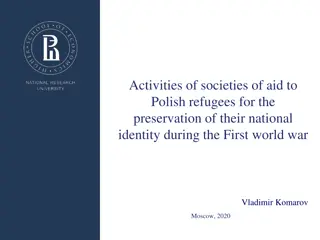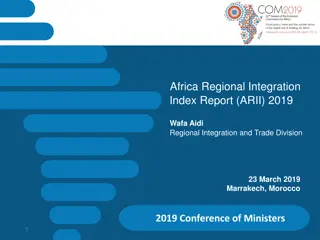Rethinking Integration and Multiculturalism in Contemporary Societies
The dichotomy between integration and multiculturalism is being challenged as outdated, with evolving national models and policies towards immigrants. The traditional assimilation model is giving way to more inclusive approaches that recognize cultural diversity and minority rights. However, criticisms exist regarding the coherence and effectiveness of these models in practice, emphasizing the importance of factors beyond policies in fostering migrant inclusion.
Download Presentation

Please find below an Image/Link to download the presentation.
The content on the website is provided AS IS for your information and personal use only. It may not be sold, licensed, or shared on other websites without obtaining consent from the author.If you encounter any issues during the download, it is possible that the publisher has removed the file from their server.
You are allowed to download the files provided on this website for personal or commercial use, subject to the condition that they are used lawfully. All files are the property of their respective owners.
The content on the website is provided AS IS for your information and personal use only. It may not be sold, licensed, or shared on other websites without obtaining consent from the author.
E N D
Presentation Transcript
Integration versus Multiculturalism: An outdated dichotomy Maurizio Ambrosini, university of Milan
The issue of integration It arises in relation with the permanent establishment of foreign citizens labelled as immigrants It does not regard foreigners perceived as well- off Cultural diversity is seen as a problem when it mingles with economic poverty In this case, immigration is perceived as a threat for social (and political) order
National models Temporary model (or guestworker model): Germany until the 70 of XX century. Immigrants as workers, not as new citizens Assimilation model (France, USA in the past). Immigrants as future citizens, but giving up their cultural features Multicultural (or pluralist) model (UK in Europe; Canada; Australia): acceptance/ promotion of cultural identities and minority institutions
Temporary model Immigrants accepted only on a temporary basis (usually 5 years) as workers Residence permit related to a labourcontract Rotation policies (failed) No families No citizenship (right of blood) Minimal integration Equal treatment in employment
Assimilation model Countries proud of their civilization, of their democratic values But with demographic problems Immigrants (selected) as future citizens More easy access to citizenship, especially for the second generation (right of soil) Demand to adopt language and local customs Mistrust towards ethnic groups and minority cultural demands (the issue of veil in France)
Multiculturalist model Recognition of minority groups and cultural rights: migrants as collective actors Support to immigrant associations Support to cultural and artistic production by minority groups (some) affirmative actions Few practical implementations
Criticism towards models Laws and policies are less coherent, more diversified, more stratified, than models could suggest Policies respond mainly to specific issues (refugees, families, second generations ): at the end, they are not so different from one model to another model Inclusion of migrants does not depend only on policies: labour market, other policies, social acceptance matter. Local policies can differ from national policies, sometimes compensating their shortcomings
The advent of multiculturalism Multiculturalism was the prevailing frame of reference for immigration policies in the last two decades of the XX century Permanent settlement of immigrant populations in Europe Movements for civil rights and for the recognition of minorities Protest against the traditional assimilationist approach From demand for equality to identity pride, and the inversion of the stigma (black is beautiful) Islam as the main battlefield
Failure of multiculturalism? In Europe national governments are taking the distance from a multicultural discourse, coming back to a more assimilationist approach This trend corresponds to the prevailing attitudes in the public opinion and to the growing of the topic in the political agenda
Multiculturalism: a map of meanings Analytical dimension (the multiethnic society as a fact to understand) and normative dimension (demand for cultural rights) Moderate and more radical positions Multiculturalism as a strategy of inclusion and as a strategy of differentiation
Crisis of multiculturalism? Multiculturalistdiscourses have taken a U turn: after a peak of consensus in the 80- 90s, they are now under attack Nowadays, many governments are again emphasizing the assimilation in the receiving society
The criticisms of multiculturalism It fosters parallel lives , separated communities, radical stances It legitimizes the oppression of women, young people, dissenters It treats cultures as solid and homogeneous entities; actually, they don t exist in such a way It fosters the establishment of separate ethnic groups (public recognition, resources, jobs )
Actual policies They have experienced a less dramatic change The multiculturalist rhetoric produced modest practical interventions, that did not deeply affect the structural dimension (inequalities, discrimination) The backlash against multiculturalism , as the emphasis on secularism, did not prevent the development of relationships with various religions, and in particular with representatives of Islam in many countries
The practical and local dimension Policies depicted as multiculturalist do not differ very much, in practice, from serious policies of integration The national experiences are not contrasting, as it is commonly believed (France vs. UK) Now, the change of discourse has limited practical effects Local policies differ from national (declared) policies (e.g. the case of Islam in France)
The issue of integration It arises in relation with the permanent establishment of foreign citizens labelled as immigrants It does not regard foreigners perceived as well- off Cultural diversity is seen as a problem when it mingles with economic poverty In this case, immigration is perceived as a threat for social (and political) order
Neo-assimilationism and civic integration Assimilation: it is the policy to make immigrants similar to the native population, and even to force them to behave as native citizens Civic integration as the prevailing trend in the EU after 2001 New emphasis on learning the national language and on its evaluation through examinations Language as test of political loyalty Integration agreements in France and in Italy
Common basic principles of immigrant integration policy (Council of EU 2004) Integration is a dynamic, two-way process of mutual accommodation Integration implies respect for the basic values of the European Union the freedom to practice one s religion and culture , but with respect for the equality of women , the rights and interests of children , and the freedom to practice or not to practice a particular religion
Common basic principles of immigrant integration policy (Council of EU 2004)(cont.) Employment is a key part of the integration process Basic knowledge of the host society s language, history, and institutions is indispensable to integration Access for immigrants to institutions, as well as to public and private goods and services, on a basis equal to national citizens and in a non- discriminatory way is a critical foundation for better integration
Other concepts Inclusion/ incorporation Interaction Coexistence Interculturalism Strong and weak points of each of them
Interculturalism In Italy as in other EU countries, interculturalism is often emphasized as the new, right way to manage cultural diversity related to immigration It is conceived as a middle way , between assimilation and multiculturalism It should encompass recognition and respect for minorities, but also dialogue and tension towards common values
The shortcomings of intercultural discourse Unclear contents and boundaries: especially in schools, every activity involving students with an immigrant background is labelled as intercultural Normative bias Proximity and confusion with civic integration Proximity with some sort of moderate multiculturalism
The issue of diversity While the fortune of multiculturalism is declining, many topics related to it are now reframed under the label of diversity Diversity is more widely accepted It is an individual attribute, not a collective entity It connects ethnic diversity with other diversities: sexual, cultural, linguistic It can have positive economic implications ( diversity management )
Integration It could be defined as the process of becoming an accepted component of the society (Penninxand Martiniello, 2007) It does not mean assimilation in old terms It implies a process of mutual adaptation It encompasses structural and cultural elements (not only interaction ) It gives responsibilities to both parties: immigrants and receiving society (not only inclusion ) It occurs mainly at local level
Three aspects of integration 1) structural: have a job, a home, a sufficient income 2) relational: be accepted, have acquaintances and friends of different origin 3) personal: have the will to insert into the new society, to learn the language, to take part in the social life
Which future for multiculturalism We need another discourse, as in the case of social cohesion: probably the idea of diversity could help Many multiculturalist stances can be maintained with liberal arguments: freedom of wisdom, freedom of association, citizenship (and double citizenship), struggle against discrimination The topic of cultural rights can be founded in forms which should be compatible with individual rights The public role of religions, as sites where norms and values are constructed, has to be reconsidered
